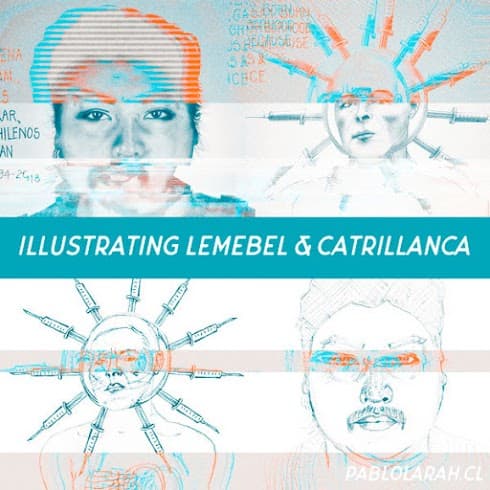Illustrating Lemebel & Catrillanca
Pedro Lemebel & Camilo Catrillanca.
Like most of the countries in America and the Third World, Chile has an indigenous people background. The vast majority were already exterminated by the Spanish conquerors in the first centuries after America's Discovery. But some of them survived, mixing with the Spanish people or maintaining their ethnic population with little or no mix. The biggest and most known group is called Mapuche (from "mapu" in Mapudungun means land and che, which means people), called Araucanos by the Spanish people.
Pedro Lemebel and Camilo Catrillanca were two prominent mapuche-descendents person.
1.- PEDRO LEMEBEL:

Pedro Segundo Mardones Lemebel (21 November 1952 – 23 January 2015) was an openly gay Chilean essayist, chronicler, and novelist. He was known for his cutting critique of authoritarianism and for his humorous depiction of Chilean popular culture, from a queer perspective. He was nominated for Chile's National Literature Prize in 2014. He died of cancer of the larynx on 23 January 2015 in Santiago, Chile.
Wikipedia
The second time, I saw him running with super tall high hills in direction of the Beaux Arts Museum. He looked tall and thin, completely dressed in black and with a red scarf on his neck. He was wearing a french black hat.
By that time I was reading his works and enjoying the sexual references and the use of the language. I did not understand why he was using the language in that way, creating new words like only gays do. If you have gay friends, maybe you can relate to this. It took me a lot of time to figure out the reason. But I finally did it. This is a prerogative of the people who creates worlds. I always wrote pieces by myself, but I was confined by the limits of the correct language. Suddenly I understood you can create whatever you want, even your mother tongue.
The last time I saw him, in the first years of the 2000s, he was drinking a coffee in the same neighborhood of the Beaux Arts Museum. He was looking super small and thin, drinking a coffee at La Rosa, known for their cinnamon or rose ice cream.
The voice of the minorities was fading away and I could feel it.
He died of cancer when I was not living in Chile anymore.
I wrote a version in Spanish on my blog En Español. Check it here:
https://enespanol.pablolarah.cl/la-ausencia-de-pedro-lemebel

In a confusing incident, he was shot in the back by a Chilean Policeman, of a force known as the "Tactical reaction Group", trained in Colombia by the forces who fought the Drug Trade. That is why they were called "Jungle Comando". Chile prepared a force that fought a guerrilla to control an ethnic minority.
Camilo was working in the country and he was going back home in his tractor.
The Jungle Comando declared that was a shooting and they declared Catrillanca was part of a gang that stole three cars.
When he was killed, he was accompanied by a 15-year-old kid. The minor was tortured by the police.
All the policemen had the due to carry a camera with them. The hard drive of the cameras was destroyed by the policemen. Before, they declared they did not have cameras with them when the shooting occurred.
Now you can see the actual footage of the shooting on Youtube and some of the policemen are being prosecuted.
And now, we know he was shot in the back on purpose. He was 24, had a 6 year old daughter and his wife was pregnant. And he was innocent.
"Arauco has a grief
Darker than his chamal (poncho)
It is not longer the Spanish people
That makes them cry
Now are the Chilean themselves
That deny them their bread."
Violeta Parra
Behind the Scenes
Font in use: Forward by 1871 Project
Illustration Techniques: Sketch with graphite pen and paper. Digital illustration made in Photoshop.













Comments
Post a Comment